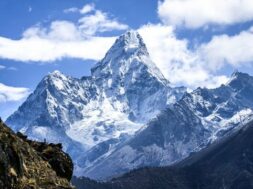
Himalayan Glaciers Melting at an ‘Exceptional’ Rate: Study
New Delhi: A study conducted by the School of Geography, Leeds University, revealed that the Himalayan glaciers are melting at an exceptional rate. 14,798 glaciers have lost 40 percent of their area since the Little Ice Age, 400-700 years ago.
Co-author and Deputy Head of Leeds University, Dr. Jonathan Carrivick, said, “Our findings clearly show that Himalayan glaciers are losing ice at a rate at least ten times higher than the average rate over past centuries. This acceleration in the rate of loss has only emerged in the last few decades and coincides with human-induced climate change.”
The researchers also predicted an increase in mean sea level due to melting glaciers. Anil Kulkarni, Glaciologist at the Indian Institute of Science, said, “The glaciers will continue to shrink at a rapid pace till mid-century, leading to higher run-off. After mid-century, the run-off will gradually decrease as the glaciated area would have reduced. It will impact seasonality of water availability and total water availability in the region.”
“The region will experience warming between 2.6 to 4.6 degrees by the end of the century, thereby causing severe hydrological and agricultural impacts in the country,” an Indian study predicted.
According to researchers, the eastern ranges near Nepal and Bhutan are more susceptible to ice shrinking and global warming. Meanwhile, a study on climate change over India by the Ministry of Earth Sciences said in 2020, “The Hindu Kush Himalayas experienced a 1.3-degree increase in temperature between 1951 to 2014, with a declining trend in snowfall and glaciers retreat in the recent decades.”
“While we must act urgently to reduce and mitigate the impact of human-made climate change on the glaciers and meltwater-fed rivers, the modelling of that impact on glaciers must also take account of the role of factors such as lakes and debris,” Carrivick said.
The Himalayan range has the third largest glacier cover after Antarctica and the Arctic. The melting of glaciers will directly impact the millions of people dependent on the Himalayan river systems for food, occupation, and energy.
(Avya Mathur)













